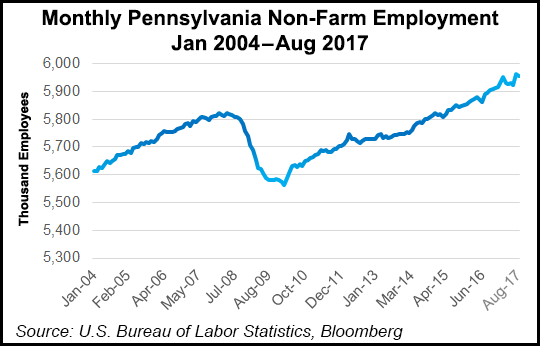Marcellus | E&P | NGI All News Access | NGI The Weekly Gas Market Report | Utica Shale
Chevron, Peoples Natural Gas Throw Weight Behind Growing Pennsylvania Economy
Chevron Appalachia LLC and Peoples Natural Gas have joined forces on an initiative aimed at fully unlocking the economic potential of Pennsylvania’s shale gas.

Company executives shared their vision for the “Forge the Future” initiative on Wednesday at the Shale Insight conference in Pittsburgh. While the shale gas industry has been an economic boon for the state in recent years, they said it’s still limited by a lack of regional demand for the energy produced. That has prevented Pennsylvanians from realizing the full benefits of the resources at a time when the state’s economy, population and coffers have periodically stagnated.
More than a year ago, Chevron and Peoples commissioned McKinsey & Company to conduct an analysis to determine the opportunities created by the state’s increasing shale gas production and how best to prioritize them. Finished over the summer and shared at Shale Insight, the analysis acknowledges a finite window of opportunity to “lock in the benefits to Pennsylvania for years to come,” as it competes with other growing basins.
The analysis serves as a first step to lay out “simple and achievable strategies that should serve as a road map” for both the private and public sectors, Chevron Appalachia President Stacey Olson told the crowd. “That’s if and only if we can realize the full potential of a natural resource under our feet,” she said. “And that’s not necessarily a given.”
Peoples CEO Morgan O’Brien noted that there’s still much work to be done. He said that no one was currently acting on the initiative, urging conference attendees to get involved.
The analysis identified three major development strategies that should be pursued. More Pennsylvanians, the study said, could benefit if natural gas-fired power is increased. The petrochemical industry should be rigorously expanded to build on Shell Chemical Appalachia LLC’s decision to construct a multi-billion dollar ethane cracker in the western part of the state. And natural gas pipeline projects should be expedited to stoke more upstream development. A strong upstream sector, Olson said, is the key to creating more downstream opportunities.
The study estimates that if the state pursues the recommendations, it could see a $60 billion increase in gross domestic product over the next decade and 100,000 more jobs. The analysis cautions, however, that achieving those outcomes will require work to address the skilled labor gap, keep engineering talent in the state and attract higher growth sectors.
Chevron Appalachia, Olson said, has been operating at a “minimum activity level” for two years now. The producer is one of the Marcellus Shale’s largest acreage holders, according to NGI calculations. Peoples could benefit from the plan as well. It is the state’s largest natural gas distributor, serving 700,000 customers in the shale-rich western portion of the state in addition to those in West Virginia and Kentucky.
The companies are not alone in their efforts, though. The analysis was also rolled out to complement other recently released studies that demonstrate the region’s vast potential to attract more petrochemical manufacturing; build the underground natural gas liquids storage to sustain those kinds of operations, and show how that growth might impact the economies of Ohio, Pennsylvania and West Virginia. Lawmakers from the region are also pushing federal agencies to study the feasibility of an underground storage and distribution hub as the public and private sectors ratchet up their efforts to take advantage of the region’s natural resources.
Shale gas production in Pennsylvania alone has skyrocketed in recent years, pushing the state to the rank of the nation’s second largest producer behind Texas. Unconventional production hit a record 5.1 Tcf in 2016, up 11% from the prior year.
Going forward, the analysis suggests that Pennsylvania’s private and public sectors work on targeted initiatives “to attract the right companies, prioritize the right infrastructure and ensure Pennsylvania’s low-cost gas and human capital translate into competitive opportunities.”
© 2024 Natural Gas Intelligence. All rights reserved.
ISSN © 2577-9877 | ISSN © 1532-1266 | ISSN © 2158-8023 |
